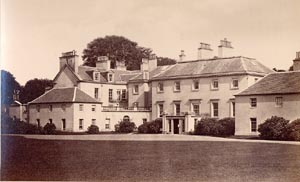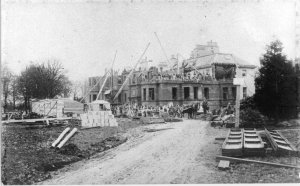By the late Sir Claud Hagart-Alexander
The
first documented records of our branch of the Alexander family, Alexander
of Paisley, date from 1413 when Richard Alexander was a lawyer, and
was recorded as being feu superior of Paisley Abbey. Members of the
family continued in this role until the mid seventeen hundreds, when
they moved to Southbar at Erskine. Claud Alexander of Southbar became
paymaster general of the East India Company, and on his return from
India, bought Ballochmyle House and Estate in 1776. At that time Ballochmyle
Estate was substantially bigger than it is now. The house was somewhat
smaller than we know it today, and was by all accounts most attractive. |
 |
Photo courtesy
of Sorn Castle |
| Previously
Ballochmyle had belonged to the Whiteford family. They unfortunately
lost heavily in the collapse of the Ayr Bank. This was a disaster that
ruined many Ayrshire families; many lost their entire fortunes. However
just before this disaster, Robert Burns had written a poem, “The
Bonny Lass of Ballochmyle” with Miss Whiteford in mind, but fate
struck before he managed to get it delivered. Nothing daunted, Burns
delivered the poem and accompanying letter to Wilhelmina Alexander,
the new Laird’s sister. Wilhelmina was delighted, but Claud was
furious. A few years later it seems Wilhelmina faded into obscurity
when she moved away to London, where it appears she married, and eventually
died. Her place of burial is unknown.
Claud the first of Ballochmyle had three sons, Claud Alexander, William Maxwell Alexander, and Boyd Alexander. William Maxwell was an architect, and was the laird of Ballochmyle when the Glasgow Dumfries and South West Railway Company came to bring the railway through Mauchline. William Maxwell refused the company way leave, until he had approved the design of the Ballochmyle Viaduct. The preliminary work on the viaduct was started in March 1846. Claud also built Catrine village and the mill along with David Dale, both with the same objective, of creating a model co-operative style community. I am descended from Boyd; he was my great great grandfather. His son Claud fought in the Crimean War, and eventually became a Major General in the Grenadier Guards. He was also a Member of Parliament for the South Ayrshire constituency for ten years. His wife, my great grandmother felt that Ballochmyle House (above) was too small for her family, and extended the house substantially, transforming it into what it was until recently. The “new” house was finalised in 1887. My grandfather moved south in about 1900, where he became a fairly eminent zoologist, he kept a zoo, and had a substantial collection of animals. When Sir Claud went south, Ballochmyle House was rented until 1938, when it was sold to the Scottish Home and Health Dept, for Ballochmyle Hospital. My grandfather’s second son was Wilfred, and was my father. Wilfred became British Consul in Beijing, which is where I was born, in the British Embassy. My father died of an unknown oriental fever while in Beijing, and my mother brought my two sisters and me to the UK when I was still an infant. When my grandfather died in 1947, I became the Laird of Ballochmyle. Sir
Claud Hagart-Alexander |
This
article was originally written
by the late Sir Claude Alexander in Oct 2002
for the booklet given out at the unveiling of Mauchline's
Jean Armour statue on 30th November 2002.
(Produced by Mauchline Burns Club)
